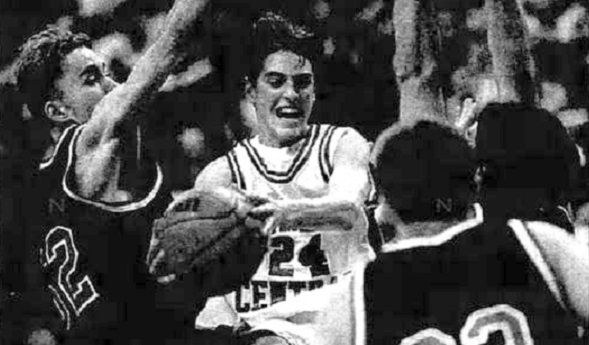
Hoops History Filled with District Stunners
By
Ron Pesch
MHSAA historian
March 9, 2018
The opinions expressed in the following are those of MHSAA historian Ron Pesch, and are not, necessarily, those of the folks who grant Pesch the chance to express them.
You are advised.
Life, sometimes, is unfair.
Despite healthy eating habits, lots of exercise, plenty of sleep, appropriate amounts of water, brain teasers, and blood pressure medicine – all those things that should, hopefully, extend a life – occasionally, our last breath arrives before the awarding of the gold watch or a trip to Disneyland.
The MHSAA Boys Basketball Tournament, sometimes, is like life. And that’s the way it should be.
The postseason is where all teams across the state are rewarded with a second chance, regardless of regular season win-loss record. In the thrilling one-and-done playoffs, highly ranked foes can be next-door neighbors or distant strangers; known only via rumor, newspaper rankings, or in these high-tech times YouTube clips. A knockout punch, ousting a team from the tournament, is most often delivered by a “worthy” opponent.
From time to time however, the end of the road arrives when least expected, via defeat by a less talented team vying for a cherished brand. “Underdog,” “Long Shot,” “Dark Horse” and “Cinderella” are the Nike®, Addias®, Reebok®, and Under Armour® of the unknown and under-achieving. Each brand is worn with pride. Everyone, including sportswriters, loves a sleeper.
In Michigan, with minor alterations, the MHSAA basketball postseason functions much as it always has operated. Champions are rare – by design, only four teams can finish the season with victory. Logistics and economics mean a team’s toughest opponent might arrive anywhere along the path. Districts are established based on schools of similar enrollment size found in logical geographic boundaries. District champions advance to play opponents in defined regions, and Regional winners move on to the final three rounds to determine those four statewide MHSAA champions. The state’s largest schools battle for the Class A title, while the smallest chase the Class D crown.
Therein lies the beauty. The playoff experience for today’s athletes is very much the same as it was for their fathers, their grandfathers and their great-grandfathers. The next opponent is luck-of-the-draw, based on a district line, and beyond a team’s control. Come game time, a blown breakaway, a bricked or air-balled jumper, or a rimmed shot that doesn’t fall can mean dreams of trophies, medals and glory, vanish from view. Tournament time does not discriminate. End game can happen to anyone.
Just like in daily life.
Sometimes, the toughest challenges arrive quicker than we feel they should. Within can be heartbreak, and, often, our greatest lessons.
Beware – the tournament tipped off again this week, and more than 120 District titles will be up for grabs tonight.
The MHSAA Tournament pre-dates Disneyland by 30 years. After assuming administrative control of high school sports in the fall of 1924, the Association made a move to expand the annual boys basketball tournament from three classifications to four with the addition of Class D in 1926.
Five years later, beginning in 1931, the public schools from the city of Detroit exiled themselves from the tournament. A year later, the schools in the Upper Peninsula did the same. Those moves, recent research shows, came from a general philosophy by local and national education authorities that there was an over-emphasis on competitive athletics. In the city of Detroit, the move meant a departure from statewide competition that would last for more than 30 years.
“The elimination of Upper Peninsula schools from state competition was the recommendation of its two (seats) on the (MHSAA representative) council,” came the report from the Lansing State Journal. “They deplored the long distances involved in sending teams from that section to the state tournament.”
Certainly, the depth of the nation’s Great Depression was a force that also insured distinct peninsula tournaments, at least in the earliest years of the separation. So, from 1932 through 1947, the MHSAA sponsored both Upper and Lower Peninsula tournaments, and crowned titlists on both peninsulas.
In 1941, and for nearly 20 years, the state’s smallest schools christened their own Class E champion. By far, the overwhelming majority were located in the vast Upper Peninsula, so it was a U.P.-only tournament.
Thereafter, a few twists of fate combined with population demographics to alter the shape of the event.
The number of schools, as well as their enrollments, played into the scheduling of action. For many years, Class A schools (as well as Class B schools for a few seasons), didn’t begin tournament play until the Regional round. Classifications were based on enrollment, with the state’s largest schools playing in Class A. Since there were relatively few Class A schools, when compared to Class C or Class D, fewer postseason games were required to identify a state champion for schools in the upper classifications. During the 1953-54 school year, there were 75 Class A schools, all in the Lower Peninsula. In Class B, there were 180 schools, (including 17 in the U.P.), while Class C included 246, (18 across the Straits). There were 181 Class D schools in the Lower Peninsula, (with 21 schools each in Class D and Class E in the U.P.). Hence, the path to a crown was, at least statistically speaking, more challenging for a smaller school.
With the post-war baby boom, and the growing size of the suburbs around the state, the first Class A Districts were held 60 years ago, in 1958. With that, the chase became more equal.
In 1961, for the first time, a Class A District tournament was held above the Straits. Played at Sault Ste. Marie, it included four teams, “with two U.P. teams, Sault and Escanaba, competing against two Lower Michigan quintets, Alpena and Traverse City,” according to the Ironwood Daily Globe.
In 1962, Detroit Public Schools ended their self-imposed exile and rejoined tournament play. With the return of those 20 schools, the first statewide prep tournament in 32 years now included 749 teams. Class A included schools with 900 or more students, Class B with between 400 and 899 pupils, Class C 200 to 399 and Class D for schools with enrollments of fewer than 200 students.
Beginning with the 2018-19 school year, basketball will move to divisions versus classifications, where the number of schools competing for a division title is uniform.
No. 1 Goes Down
Devastating District Defeats
It doesn’t happen often, but it does happen. Every now and then, Michigan’s top-ranked teams fall in the opening round of the MHSAA tournament.
1952 – Class C - Muskegon Western Michigan Christian 39, Muskegon St. Mary 36
Given little chance of surviving opening night Class C District play at Fremont High School, Muskegon Western Michigan Christian “had to do it the hard way, coming from behind with a last ditch rally that had the overflow throng on the edge of their seats.”
 Twice beaten by St. Mary during the regular season, the Warriors opened a surprising 13-5 lead through the first quarter, behind the shooting of Gordon DeKruyter and Dave Bolema. The two seniors would end the game with high-scoring honors at 14 points apiece.
Twice beaten by St. Mary during the regular season, the Warriors opened a surprising 13-5 lead through the first quarter, behind the shooting of Gordon DeKruyter and Dave Bolema. The two seniors would end the game with high-scoring honors at 14 points apiece.
“I don’t remember much,” said the 83-year-old DeKruyter, laughing at the thought that Christian’s 39-36 victory over heavily favored Muskegon St. Mary was being recalled some 65 years later. “I’ve always thought it was hard to beat a team three times in a season. I guess that’s still the same today.”
“We had some real good contests in the old 4C Parochial League,” added DeKruyter. The league included Christian, and three Muskegon-area Catholic schools – St. Jean, St. Joseph and St. Mary. “We didn’t have our own gym back then, so we practiced on a short court at Muskegon’s Froebel School. Our coach, Elmer Wolcott, went on to win a number of state championships.”
Christian’s early lead, however, evaporated as the game quickly evolved into a real battle. St. Mary closed the gap to a point, 18-17, before the intermission, and then appeared to grab control of the game, 25-18, following the break.
“The game has seen quite a transition since those days of the set-shot,” said DeKruyter, who later played at Calvin College, then refereed for 27 years. “The biggest is the 3-point shot. It’s amazing how much it has changed the game.”
Another Christian rally knotted the contest at 31-31. The Warriors then grabbed the lead 35-33, but again lost it, trailing St. Mary 36-35 with two minutes to play. Bolema responded with a basket, and combined with a stop on St. Mary’s next possession, the stage was set for a stall by WMC for the victory. However, an errant pass, stolen with 18 seconds remaining, put the game on the line. In the vanishing seconds, filled with the pressure, intensity and noise of a win-or-go-home tournament March, St. Mary’s layup, likely separating victory and defeat, rimmed the basket and fell out.
DeKruyter snared the rebound and added an insurance basket just before the final whistle.
The celebration would last until the Regional Final. Along the way, WMC vanquished White Cloud, another surprise survivor of opening day District madness, by a point, and Lansing O’Rafferty by three, before falling by eight points to Holt.
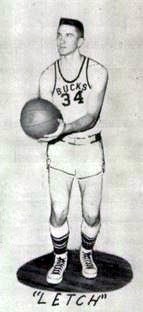 1955 – Class B – Buchanan 60, St. Joseph 57
1955 – Class B – Buchanan 60, St. Joseph 57
“It took two years but Jim Letcher got sweet revenge for a foul committed late in the district final in 1953 which gave the Bears a one point victory,” wrote Ed Lukas in the St. Joseph Herald Palladium. “Last night at the Buchanan gym, Letcher poured in 30 points to lead his Buck teammates to a 60-57 upset win over the highly touted St. Joseph Bears …”
The top rated team in Class B by the Detroit Free Press, St. Joseph had beaten Buchanan in both regular-season meetings. The winner of this matchup was expected to emerge as District champion. Indeed, Buchanan did just that, but barely, with a 47-45 win over Dowagiac. The Bucks rode the victories to the state finals, their first trip to the title game since 1928, before falling to River Rouge, 51-48, ending the year with a 17-7 mark.
1965 – Class C – Fowlerville 59, Portland 58
“Fowlerville, which did not have a winning record during the regular season, came up with the first major upset of the state high school basketball tournament Thursday night by edging previously unbeaten and top-ranked Portland, 59-58, in a Class C district … at Sexton,” wrote Ernie Boone for the Lansing State Journal. “Greg Braun, who only had six points all night and just one in the final period when Fowlerville took over the lead, sank a free throw with five seconds remaining to provide the winning margin.”
Fowlerville’s tournament run ended that Saturday as Williamston sank six free throws in the last two minutes of the District Final to emerge with a 48-46 win.
1969 – Class D – Detroit All Saints 62, Wyandotte Mt. Carmel 60, OT
“A perfect season and dreams of a state Class D basketball title went up in smoke Wednesday night before 3,000 fans for Wyandotte Mt. Carmel,” said Hal Schram in the Detroit Free Press. “Winner of 15 straight games and rated No. 1 among state powers in its division, Mt. Carmel bowed to old tormentor All Saints, 62-60, in a frenzied overtime period.
“Mt. Carmel has lost only three games in two seasons. All three losses came at the hands of the Saints.”
Detroit All Saints, reigning Class C state champ and ranked No. 3 by Schram, grabbed the District title before falling in the opening round of the Regionals to unranked Ypsilanti St. John, 65-62. Bob Sutton led all scorers with 21 for St. John in what was the upset of the tournament to that point. The Saints finished the year at 18-2.
1979 – Class A – Detroit Northeastern 95, Detroit Murray-Wright 91, OT
“Crash!! Murray-Wright High became the first big casualty of the 1979 state basketball tournament Tuesday night when the highly favored Pilots of coach George Duncan fell before underdog Northeastern, 95-91, in overtime at Highland Park High,” wrote Schram in the Free Press, describing the mayhem of the opening round to the District.
“Murray-Wright went into the game champion of Detroit’s Public School League and rated Michigan’s No 1 Class A team. But its 19-game winning streak ended when Joe Rodgers hit four straight free throws in the final 25 seconds of overtime to give the Falcons their most prized victory of the season.
“The Northeastern victory rubbed out another whirlwind comeback by Murray-Wright, which had to score 34 points in the final period to tie the game. … With 1:11 left in regulation, Northeastern led, 85-78, but the Pilots tied it with seven seconds left on Anthony White’s basket.”
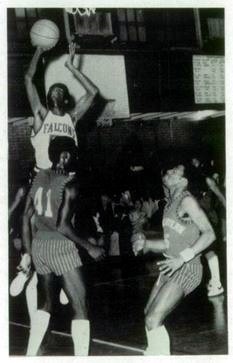 The likelihood of a rocky road to the title game for Murray-Wright was identified by Schram earlier in his write-up that accompanied his final regular-season ‘Top Ten’ rankings, a feature of the Free Press that dated back to the late 1940s. “There’s a dozen or so teams in Class A who could wind up with the big trophy. … Murray-Wright just might not get out of its own District where it has to meet and beat the likes of Northeastern, Highland Park or Northwestern.”
The likelihood of a rocky road to the title game for Murray-Wright was identified by Schram earlier in his write-up that accompanied his final regular-season ‘Top Ten’ rankings, a feature of the Free Press that dated back to the late 1940s. “There’s a dozen or so teams in Class A who could wind up with the big trophy. … Murray-Wright just might not get out of its own District where it has to meet and beat the likes of Northeastern, Highland Park or Northwestern.”
Much to the surprise of all the state’s prognosticators, unheralded Detroit Mackenzie, sporting a lackluster 13-7 regular-season mark, and preparing to celebrate its 50th graduating class that June, also got to celebrate its first basketball state title by downing Pontiac Central, 72-64, for the Class A crown.
1982 – Class C – Orchard Lake St. Mary 63, Redford St. Mary 55
“Orchard Lake St. Mary held off a late Redford St. Mary rally Monday night to defeat the No. 1 rated team in Class C, 63-55, in the first game of district play,” said Mick McCabe from the Free Press.
“Orchard Lake … jumped out to a 26-21 halftime lead despite the Rustics’ domination of the boards in the first half. Late in the third quarter, the Eaglets built up a 19-point lead but failed to deliver the knockout punch by missing a pair of wide open lay-ups before Redford scored the final five points of the period.”
Despite two losses – to Birmingham Brother Rice and Harper Woods Bishop Gallagher – The Associated Press and Detroit Free Press had ranked Redford St. Mary No. 1 in the state. With three losses – including a 79-77 defeat to Class A Detroit Cooley decided during the final 25 seconds – Orchard Lake St. Mary sat No. 2 in the Free Press’ final poll, while AP had the Eaglets at No. 4.
Orchard Lake led by 14 midway through the final frame, but Redford went on a 9-0 run to pull within five before running out of steam. Chris Howze scored 20 points on 8 of 12 shooting from the field to lead Orchard Lake to victory. Following the win, the Eaglets tore through Class C mostly uncontested until the Semifinals. Trailing by as many as 17 in the first half, Grand Rapids South Christian, a final four contestant in the previous two years, capitalized on the loss of Howze to fouls with 5:57 to play. Able to cut the margin to three with 21 seconds remaining, the Sailors couldn’t complete the furious comeback, and fell, 66-63. Orchard Lake coasted to the crown Saturday, thumping unranked Reed City, 76-48.
1995 – Class D – Detroit Holy Redeemer 75, Detroit East Catholic 66
“Hamtramck St. Florian will host the state’s second-best (opening round District) game when Detroit East Catholic (No. 1 in Class D) and Detroit Holy Redeemer hook up again,” noted McCabe in his pre-tournament column in the Free Press. “In the (Detroit) Catholic League semifinals, East Catholic got off to a huge lead against Redeemer and then hung for the victory.”
(The state’s top District opener, referred to by McCabe, ended as expected. Detroit Country Day, ranked No. 1 in the Free Press Class B rankings, rolled to an easy 55-48 victory over Orchard Lake St. Mary, the state’s No. 3 team. Sophomore Shane Battier scored 28, grabbed 11 rebounds and blocked three shots.)
McCabe had noted Redeemer’s senior guard Jimmy Reyes hadn’t played that well in the Catholic League final. Reyes certainly had his game in the rematch as he scored 20 points, including 13 in the fourth quarter, to lead the No. 6-ranked Lions to victory. Sophomore guard Armelius Parker added 17 as Holy Redeemer began its march to the Class D title.
The rivalry between the schools would continue in the coming years. Redeemer would again knock East Catholic out of the postseason in the District Final in 1996. East Catholic extracted some revenge in 1997, downing the Lions in the second round of the District, en route to its eighth and final MHSAA basketball championship. Both schools would close following the 2004-05 school year.
1997 – Class C – Benzie Central 73, Manton 70
In the opening game of the District 91 doubleheader, played at Benzonia, senior Nate Myers bagged eight 3-pointers, including the game winner with eight seconds remaining, as Benzie Central downed unbeaten and top-ranked Manton in the Class C District opener, 73-70. Benzie had lost an 11-point lead over the final four minutes.
“The gym was unbelievably full,” recalled Bill Lynch, a former coach at Benzie Central. “Just a great crowd. As I recall, Manton didn’t come down early to practice in the gym. I thought that was a mistake.”
Following the victory, Benzie Central cruised to the Semifinals before falling to Three Oaks River Valley in a frenzied 67-65 thriller. Trailing by 14, River Valley rallied back and was up three, 65-62, when Myers again bagged a clutch triple with just 11 seconds remaining to knot the game. But Zac Robinson would emerge as the game’s hero with a lay-up with 3.1 seconds remaining that hung on the rim “for an agonizing split second” before dropping through the net, ending Benzie Central’s dream run.
2004 – Class A – Grosse Pointe North 66, Detroit Denby 51
“Out of all the teams, that was the one team I was really concerned with,” said Detroit Denby coach Ray Reeves to McCabe about the draw of his team’s opponent prior to its Class A District opener with No. 9 Grosse Pointe North. “We beat them last year by 14, but it was a tough game. We made them play our style, and it wore them down.”
His concerns were warranted. Trailing by six to open the final quarter, North’s Mark Bramos scored 15 of his 25 points in the fourth as North toppled No. 1 Denby, 66-51, in Class A opening round District action.
“We saw them play Renaissance at Cobo, and that helped us a lot,” said guard Bryan Bennett, who scored 11 points for North. The Norsemen won the District, downing two more PSL squads Southeastern and Finney, but lost to eventual quarterfinalist Utica Eisenhower, 56-52, in their Regional opener.
 Ron Pesch has taken an active role in researching the history of MHSAA events since 1985 and began writing for MHSAA Finals programs in 1986, adding additional features and "flashbacks" in 1992. He inherited the title of MHSAA historian from the late Dick Kishpaugh following the 1993-94 school year, and resides in Muskegon. Contact him at [email protected] with ideas for historical articles.
Ron Pesch has taken an active role in researching the history of MHSAA events since 1985 and began writing for MHSAA Finals programs in 1986, adding additional features and "flashbacks" in 1992. He inherited the title of MHSAA historian from the late Dick Kishpaugh following the 1993-94 school year, and resides in Muskegon. Contact him at [email protected] with ideas for historical articles.
PHOTOS: (Top) Benzie Central’s Nate Myers drives between Three Oaks River Valley defenders in 1997. (Middle top) Muskegon Western Michigan Christian’s Gordon DeKruyter in 1952. (Middle) Buchanan’s Jim Letcher in 1955. (Middle below) Fowlerville’s 1965 team. (Below) Detroit Northeastern’s Joe Rogers puts up a shot in 1979. (Photos courtesy of Ron Pesch.)

We Will Always Remember Trojans, Lumberjacks as 114-Year-Old Rivalry Nears End
By
Ron Pesch
MHSAA historian
February 9, 2024
The MHSAA basketball record book still lacks a rivalries category. The state’s football record book offers clues to likely candidates, but without deep research, the participants and sequencing of such lists will remain unknown.
Certainly, among the candidates would be the annual boys basketball battles between Saginaw’s east side and west side – Saginaw High vs. Saginaw Arthur Hill. Come Friday, Feb. 16th, 2024, twilight falls on one of Michigan’s most intense. Because of its significance, the game will be hosted outside of a high school gymnasium.
Saginaw’s Dow Event Center will stage the final regular-season showdown between the Trojans and Lumberjacks. Titled the ‘Game of Legends,’ all 5,000 tickets for the celebration were snapped up in 20 minutes. After years of discussions, at the end of the school year, Saginaw High and Arthur Hill will combine to finalize the formation of Saginaw United High School.
Based on the research of Dave Slaggert, the series between schools began during the 1910-11 season at the Saginaw Manual Training School gymnasium. Head varsity boys basketball coach at Arthur Hill from 1996 through 2001, Slaggert spent five years compiling a book documenting the rivalry. Much of the manuscript has already been committed to paper. That includes a chapter penned by Michigan State University coaching legend Tom Izzo, who highlights the uniqueness of the crosstown rivalry, the crazy fans, and the talent that brought him regularly to town. Titled “Remember the Trojans & the Lumberjacks,” the concluding chapter awaits the results of the 2024 season.
The Beginnings
In 1889, Michigan’s State Legislature consolidated the cities of East Saginaw and Saginaw City into what we know today as Saginaw.
East Side High School opened in 1865. In 1901, West Side High School was renamed Arthur Hill, in honor of a former school board president and mayor of Saginaw City.
Football teams from Saginaw High (sometimes called Saginaw Eastern) and Arthur Hill High first met on the gridiron in 1894. In 1904, both joined Flint (Central) and two schools from Bay City to form the Saginaw Valley League. During the 1910-11 season, the boys squads from the Saginaw schools squared off on the basketball court for the first time.
 “Saginaw High easily defeated the Arthur Hill High school basketball players … in the first game of the interscholastic series,” stated the Saginaw Daily News, “the final score standing 60 to 17. … (Bill) Steckert contributed 12 field baskets for the winners. … (Leo) Vondette starred for the losers.”
“Saginaw High easily defeated the Arthur Hill High school basketball players … in the first game of the interscholastic series,” stated the Saginaw Daily News, “the final score standing 60 to 17. … (Bill) Steckert contributed 12 field baskets for the winners. … (Leo) Vondette starred for the losers.”
Perhaps it was a typo – it’s impossible to know – but the final score differed in the 1911 Saginaw yearbook – “The Aurora” – when published in the spring. “Before a large crowd of enthusiastic fans, Arthur Hill was decisively defeated in the local gym, the final count being 69 to 17, with the East Siders on the heavy end.”
The author concluded with flair and flourish: “Steckert starred for Saginaw, getting 24 points to his credit, while Vondette was the celestial light for the vanquished quintet. Dancing was enjoyed after the game.”
A week later, the Saginaw girls basketball team opened its season against the west siders. According to the yearbook, “Saginaw out-played Arthur Hill and defeated them by the score of 41-4.” The newspaper credited Leona Buck as the leading scorer, with a phenomenal 29 points.
The Inevitable Finale
The doors open at 3 p.m. for the 2024 festivities at The Dow next Friday. Fittingly, the Saginaw girls team will tip off the action on the court at 5 o’clock. The girls programs already have consolidated, and the Phoenix of Saginaw United will face Flint Carman-Ainsworth – a school that consolidated in 1986. The Hill and High contest is scheduled for 7 p.m.
“It’s really going to be a big deal,” said Slaggert, thrilled by the prospect. “Saginaw’s going all out for this. They’re trying to do it up in style.”
The wrap-up comes a decade after what, initially, looked like the end.
On Feb. 15, 2014, Detroit Free Press sportswriter Mick McCabe wrote about the expected unification.
“Saginaw and Saginaw Arthur Hill likely met for the last time ever in the regular season Friday,” he wrote. Saginaw had just knocked off the Lumberjacks, the No. 2 team in McCabe’s weekly ranking of the state’s top teams.
“The Saginaw-Arthur Hill basketball rivalry is the best in the state, so you shouldn’t be surprised when the underdog wins. But Saginaw (11-6) was coming off consecutive losses to Midland and Midland Dow for maybe the first time ever.”
The school district was expected to announce the closure of Saginaw High that following Monday, merging its students into Arthur Hill. The move would mean a new school name, new school colors, and a new nickname.
Like many urban centers across the country, outbound migration of both jobs and people, combined with plunging birth rates, had altered the demographics of cities, and the education landscape.
“In just five decades, the city's population dropped from nearly 100,000 in the 1960s to fewer than 52,000 by the 2010 census,” stated the Saginaw News in 2014. “To say it another way, Saginaw lost 48 percent of its residents during the last 50 years.”
McCabe cut to what that meant to enrollment numbers at the two schools: “In 1987, Saginaw High had over 1,800 students; it is now down to about 600. Arthur Hill had 2,395 students in ’85; it now has 973.”
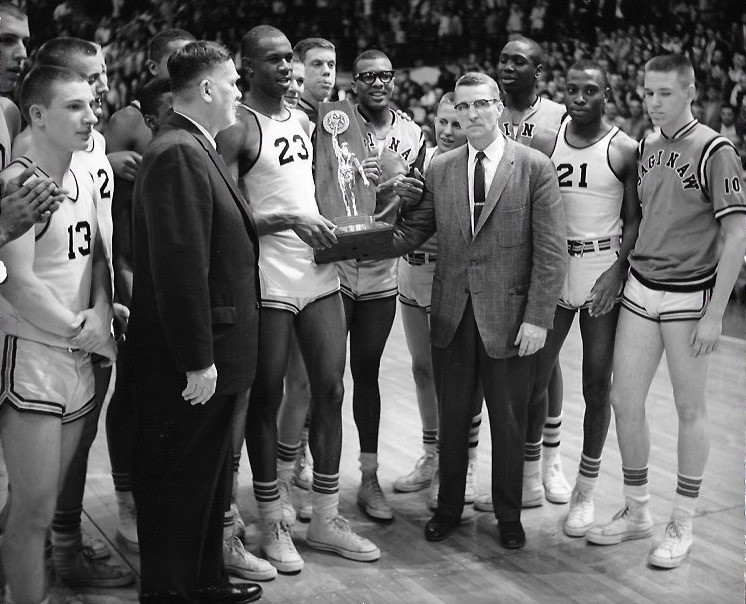 Despite the defeat, McCabe predicted Arthur Hill to be among the final four Class A teams still standing that season when the annual MHSAA Tournament shifted to Michigan State’s Breslin Center. But in the craziness of March, the Trojans again took down Arthur Hill in the Districts, 53-51.
Despite the defeat, McCabe predicted Arthur Hill to be among the final four Class A teams still standing that season when the annual MHSAA Tournament shifted to Michigan State’s Breslin Center. But in the craziness of March, the Trojans again took down Arthur Hill in the Districts, 53-51.
Adding to the madness, the expected consolidation didn’t happen. A recommendation by a Saginaw interim superintendent to close Saginaw High found no school board support.
With the potential consolidation still hovering, one year later sportswriter Bill Khan recalled other recent departures from Michigan’s classic basketball landscape in an article for the StateChamps! Sports Network:
“The Saginaw-Arthur Hill rivalry is at risk of going the way of other great urban rivalries – such as Flint Central-Flint Northern, Pontiac Central-Pontiac Northern, Lapeer East-Lapeer West, Detroit Cooley-Detroit Southwestern, Detroit Mackenzie-Detroit Redford, Detroit Kettering-Detroit Northeastern, Detroit Miller-Detroit Northern and Detroit Southeastern-Detroit Eastern, that have ended in years past due to school closures and consolidations.”
Arthur Hill downed the Trojans twice during the 2014-15 regular season league action, and again in postseason District play, before finishing the year as Class A runner-up, and the holding pattern of the planned school merger continued.
Enrollment numbers continued to drop at both schools and after much community and school board debate, construction on a brand-new five-story Saginaw United High School began in 2022.
A Celebration of Statistics
The state basketball tournament kicked off in 1917. Over 107 years, on only two occasions – in 1943 during World War II, and in 2020, due to COVID-19 – the tournament was not completed.
Slaggert breaks down the City of Saginaw School District’s incredible basketball history in a quick series of numbers.
“47-36-18-8,” said Slaggert, stressing a bullet point of a well-rehearsed pitch, breaking out the incredible success of the two schools come tournament time.
“During those 105 tournaments, 47 times, Saginaw High (starting in 1919) or Arthur Hill (beginning in 1930) made it into the state Quarterfinals – the final eight.
“That’s almost half of the 105 possible years. And in most cases throughout that rivalry, they would have played each other in the Districts. So how many more times would they have made it if they were coming in different brackets or different directions? “
To take that further, he noted, 36 times one of those teams made it into the final four. On 18 occasions, one of the two schools reached the state title game, and on eight occasions, they emerged as MHSAA state champions.
Six of those titles were won by Saginaw High (1942, 1962, 1996, 2007,2008, 2012). Arthur Hill’s championships were won in 1944 and 2006.
“That's a pretty incredible stat for two schools in the same town, don’t you think?” Slaggert asked.
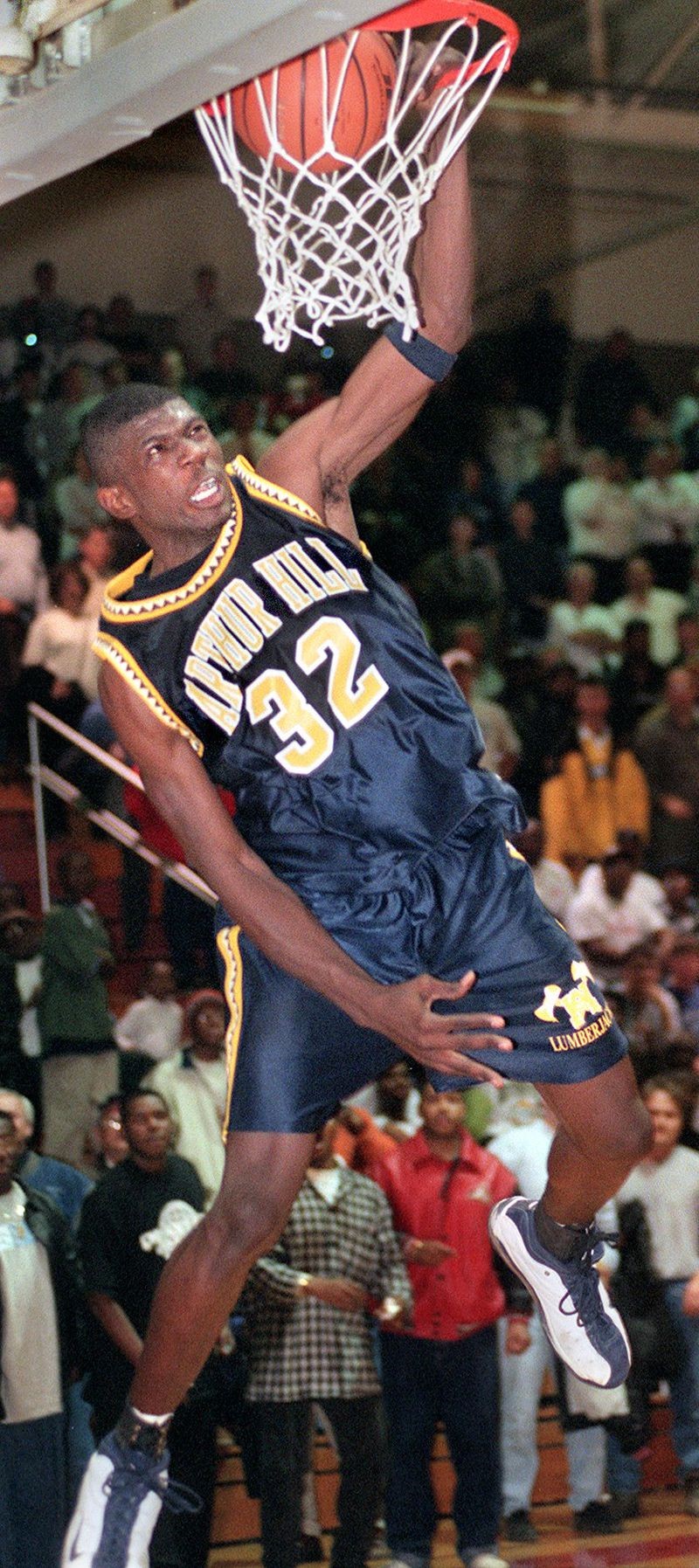 That history also points out another Slaggert challenge. As illustrated, come March the schools could, in theory, bump into each other one more time come the postseason. This year, the teams are in different Districts, and could potentially cross paths in an MHSAA Regional.
That history also points out another Slaggert challenge. As illustrated, come March the schools could, in theory, bump into each other one more time come the postseason. This year, the teams are in different Districts, and could potentially cross paths in an MHSAA Regional.
A Parade of All-Staters
Between 1938 and 2023, a combined total of 106 players from the two schools – 10 or more in each decade from the 1940s to the 2010s – have earned all-state basketball honors from The Associated Press and/or one or more of the Detroit newspapers: the Free Press, News or Times.
Since the introduction of Michigan’s Mr. Basketball award in 1981, honoring the best-of-the-best from the state’s top high school seniors, 10 players from the two schools have landed among the top five in voting: Eric Davis (AH –‘15), Maurice Jones (AH –‘10), Draymond Green (S –‘08), Dar Tucker (AH –‘07), Anthony Roberson (S –‘02), Eugene Seals (S –’00, and head coach of the United girls basketball team), Jason Richardson (AH-‘99), Jessie Drain (S –‘91) and Daryl Reed (S –‘87). Richardson won the award. Davis, Green, Tucker, Roberson, and Seals all finished second in the annual voting.
Tony Smith (S -‘74), Craig Dill (AH -‘63), Ernie Thompson (S -‘62), Webster Kirksey (S -‘51), Dick Rifenburg (AH -‘44), and Larry Savage (S -‘42) were all honored by the Basketball Coaches Association of Michigan with their Retro Mr. Basketball Award when the organization sought to honor the great seniors in Michigan high school basketball from the years 1920 through 1980. Seven others – James Koger (S -‘79), Lovell Humes (S – ’63), Bill Agre (AH -‘47), Gene Glick (AH -’46), Jack Mott (AH -’45), Eddie Johnson (S – ’43) and Stanley Paskiewicz (S -’38) – were among the candidates for that award.
Based on research by Orchard Lake St. Mary’s Robin Goddard, Saginaw High is likely the state’s winningest basketball program, trailed by Benton Harbor, Kalamazoo Central and Orchard Lake St. Mary’s.
Initially, Saginaw dominated the crosstown series with the Lumberjacks. But by the 1920s Arthur Hill overcame the deficit, and by the mid-1950s the Hill had opened a wide 25-game lead in wins versus losses. But by 1975, the gap had narrowed with the Trojans just six games back in the series. And yet, the exact status of the rivalry is still unknown, as the capture of game scores is spotty going forward.
The digging to capture those missing scores continues, as does the race to game day.
Slaggert has committed to printing 1,000 copies of his book. His challenge to date has been selling copies of something that does not yet, physically, exist. As it stands, currently there are 772 pages in the book. It includes a mind-blowing 800+ photos dating as far back as 1905. The sale price is fixed at $40. That currently means the production cost per copy exceeds the retail price, so Slaggert continues to chase sponsorships to defray the printing expense.
“It’s a non-profit effort,” he noted. “If there are any profits, they go to scholarships for the new high school. All money is run through the Saginaw Community Foundation,” which makes sponsorships tax-deductible.
His favorite memory from the series is his last victory as an Arthur Hill coach. It comes from 2001.
“Saginaw High defeated us 90-37 in the second game of that season and finished with a 17-5 season record that year,” he retold. “We had a modest 10-10 season record heading into the Districts but showed lots of improvement through the season. We met again in the District Finals. Saginaw High was led by Anthony Roberson, LaMarr Woodley, Michael Thomas and Tanoris Shepard and was ranked seventh in the state. In front of a sold-out Heritage High School crowd, our kids played their hearts out and, led by Devaundre Whitson, Omar Linder, and Freddy Jackson, pulled out a 68-66 overtime win! (It’s) my greatest thrill in coaching, and most of the old-timers say it’s the greatest upset in the rivalry.”
Slaggert retired from coaching after that season, and in the years to follow, found a desire to record the history of the series.
“I have nine living coaches from Saginaw and Arthur Hill that have written a chapter for me. I have eight others that I've written on Larry Laeding, Chuck Fowler, and different coaches that are deceased,” he said. “My intent is to give something back to my community. I didn’t do this for money. I wanted this story to be passed down to future generations – people 100 years from now about Jason Richardson, Draymond Green, Ernie Thompson, Craig Dill, and all the great ones.
“It’s a labor of love for me, I’ve really enjoyed it.”
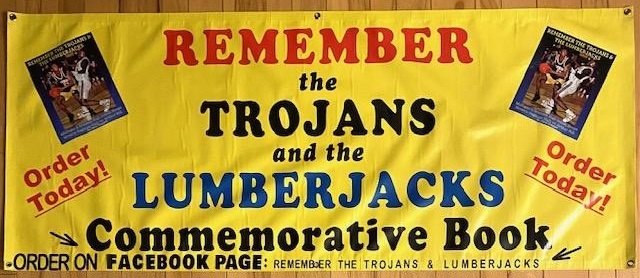 To order Slaggert's book, click for the Facebook link or visit the Saginaw Community Foundation website, click "Give Now" and select the book title as Fund. Cost is $40 with an option including shipping for $52.
To order Slaggert's book, click for the Facebook link or visit the Saginaw Community Foundation website, click "Give Now" and select the book title as Fund. Cost is $40 with an option including shipping for $52.
PHOTOS (Top) Saginaw Eugene Seals drives against Arthur Hill’s Jason Richardson – with coach Marshall Thomas in the background – during a sold-out 1999 game at the Saginaw Civic Center. (2) Arthur Hill’s Ernie Thompson and coach Larry Laeding accept the 1962 Class A championship trophy. (3) Saginaw High’s Webster Kirksey (30) puts up a shot; he graduated in 1951. (4) Richard dunks at the final buzzer as Arthur Hill downs top-ranked Flint Northwestern in a 1999 Class A Regional matchup. (Photos collected by Dave Slaggert. Top photo courtesy of Saginaw News/MLive.)

